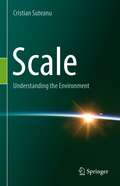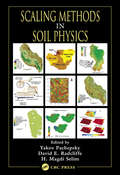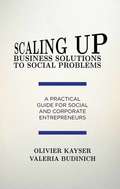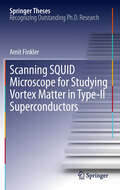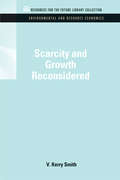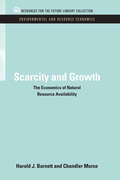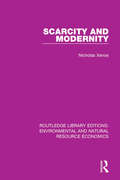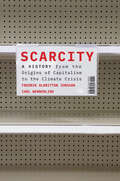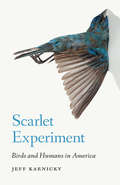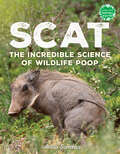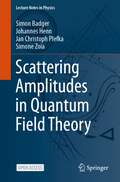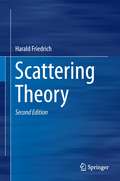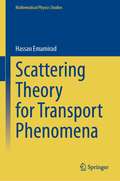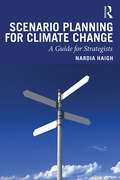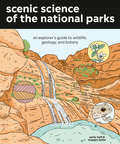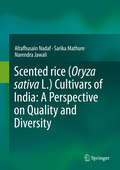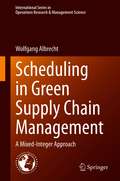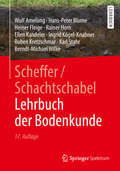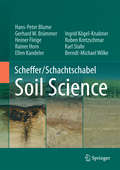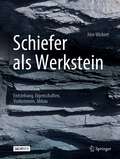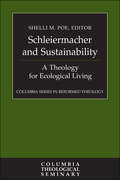- Table View
- List View
Scale: Understanding the Environment
by Cristian SuteanuThis book provides up-to-date, in-depth and accessible information on the concept of scale, and focuses on its applications in geography, Earth science, environmental science, and other fields in which the environment plays a significant role. Although the book presents methods and applications as a response to practical challenges, it is primarily concept-centered: it identifies a set of distinct, yet related notions of “scale”, analyzing and elucidating their evolving meanings in a systematic way. Concepts are defined with a focus on their practical operational applicability, and the introduction of methods is supported by concrete examples. The book links theoretical insights to illustrating applications, involving a broad range of themes, from maps, fractals, and chaos theory to fine art and literature. It approaches the subject in a spatial, temporal, and spatio-temporal context, including a wide diversity of spatial features from Earth and other planets, as well as time series and space-time patterns. This monograph is expected to be useful especially because in practice the various scale-focused concepts are not neatly separated and immiscible. It is therefore helpful for scholars in physical and human geography, Earth and environmental sciences, and other fields, to benefit from a clear conceptual framework that distinguishes and illuminates the various scale-related concepts and their interconnections. Selected chapters can also support a deeper understanding of the concept of scale for graduate and undergraduate students in geography, the natural sciences, and the humanities. Information on recommended additional literature and comments about specific sources offer a guide to further reading on the topics addressed in the book.
Scaling
by Grigory Isaakovich BarenblattMany phenomena in nature, engineering or society when seen at an intermediate distance, in space or time, exhibit the remarkable property of self-similarity: they reproduce themselves as scales change, subject to so-called scaling laws. It's crucial to know the details of these laws, so that mathematical models can be properly formulated and analysed, and the phenomena in question can be more deeply understood. In this 2003 book, the author describes and teaches the art of discovering scaling laws, starting from dimensional analysis and physical similarity, which are here given a modern treatment. He demonstrates the concepts of intermediate asymptotics and the renormalisation group as natural attributes of self-similarity and shows how and when these notions and tools can be used to tackle the task at hand, and when they cannot. Based on courses taught to undergraduate and graduate students, the book can also be used for self-study by biologists, chemists, astronomers, engineers and geoscientists.
Scaling Methods in Soil Physics
by Yakov Pachepsky David E. Radcliffe H. Magdi SelimThe scaling issue remains one of the largest problems in soil science and hydrology. This book is a unique compendium of ideas, conceptual approaches, techniques, and methodologies for scaling soil physical properties. Scaling Methods in Soil Physics covers many methods of scaling that will be useful in helping scientists across a range of soil-rel
Scaling up Business Solutions to Social Problems: A Practical Guide for Social and Corporate Entrepreneurs
by O. Kayser V. BudinichA silent revolution is underway, as entrepreneurs challenge prevalent notions of business motives and methods to invent market-based solutions to eradicate social injustice. Yet many fail to succeed. Based on original research, the authors uncover why impressive solutions fail to scale up, featuring global case studies and practical solutions.
Scaling up SDGs Implementation: Emerging Cases from State, Development and Private Sectors (Sustainable Development Goals Series)
by Godwell Nhamo Vuyo Mjimba Gbadebo O. A. OdularuThis volume challenges global leaders and citizenry to do more in order to resource the implementation of the 2030 Agenda for Sustainable Development (AfSD) and its 17 interwoven Sustainable Development Goals (SDGs). Starting from the concept ‘we cannot manage what we cannot measure’, the book presents some cases showing how to draw national level baselines for the domestication and localisation of the SDGs seeking to provide a clear roadmap towards achieving the 2030 AfSD. Scaling up SDGs Implementation is targeted at the United Nations, national and state governments, sub-national governments, the corporate sector and civil society, including higher education institutes, labour groups, non-governmental organisations and youth movements. The book is cognizant of these institutions’ common, but differentiated responsibilities and capabilities within their socio-political, environmental and economic conditions. The book presents case studies of how the corporate sector has been scaling up SDGs implementation, from the tourism sector, insurance, to the aviation and agricultural sectors. To make sure that no one is left behind, the volume includes cases on solutions for pressing environmental and socio-economic problems ranging from cooperatives in Brazil to the conservation of springs in Zimbabwe. The matter of finding synergies between the climate SDG and the Paris Agreement’s Nationally Determined Contributions (NDCs) is elaborated at length. Lastly, the book discusses how institutions of higher education remain critical pillars in SDGs scaling up, with cases of curriculum re-orientation in South Africa to the rolling out of the Women’s University in Africa. In this context, this volume challenges every global citizen and organization to invest every effort into making the implementation of the SDGs a success as we welcome the second four to five year segment down the road to the year 2030.
Scanning SQUID Microscope for Studying Vortex Matter in Type-II Superconductors
by Amit FinklerCommon methods of local magnetic imaging display either a high spatial resolution and relatively poor field sensitivity (MFM, Lorentz microscopy), or a relatively high field sensitivity but limited spatial resolution (scanning SQUID microscopy). Since the magnetic field of a nanoparticle or nanostructure decays rapidly with distance from the structure, the achievable spatial resolution is ultimately limited by the probe-sample separation. This thesis presents a novel method for fabricating the smallest superconducting quantum interference device (SQUID) that resides on the apex of a very sharp tip. The nanoSQUID-on-tip displays a characteristic size down to 100 nm and a field sensitivity of 10^-3 Gauss/Hz^(1/2). A scanning SQUID microsope was constructed by gluing the nanoSQUID-on-tip to a quartz tuning-fork. This enabled the nanoSQUID to be scanned within nanometers of the sample surface, providing simultaneous images of sample topography and the magnetic field distribution. This microscope represents a significant improvement over the existing scanning SQUID techniques and is expected to be able to image the spin of a single electron.
Scarcity and Growth Reconsidered (RFF Environmental and Resource Economics Set)
by V. Kerry SmithCurrent views on resource availability are examined, along with the original Barnett-Morse thesis of resource supply. Originally published in 1979
Scarcity and Growth: The Economics of Natural Resource Availability (RFF Environmental and Resource Economics Set)
by Harold J. Barnett Chandler MorseIn this classic study, the authors assess the importance of technological change and resource substitution in support of their conclusion that resource scarcity did not increase in the Unites States during the period 1870 to 1957. Originally published in 1963
Scarcity and Modernity (Routledge Library Editions: Environmental and Natural Resource Economics)
by Nicholas XenosOriginally published in 1989. In this book Nicholas Xenos argues that the assumption that scarcity is a universal human condition is far from universal but rather a product of western influence. Informed by the work of Baudrillard, Bourdieu, Girard, and Sahlins, this historical narrative of scarcity incorporates interpretations of texts and practices from eighteenth-century London to contemporary New York. Lucid and elegant in style, Scarcity and Modernity will appear to those with interests in social and political thought and cultural criticism.
Scarcity: A History from the Origins of Capitalism to the Climate Crisis
by Carl Wennerlind Fredrik Albritton JonssonA sweeping intellectual history of the concept of economic scarcity—its development across five hundred years of European thought and its decisive role in fostering the climate crisis.Modern economics presumes a particular view of scarcity, in which human beings are innately possessed of infinite desires and society must therefore facilitate endless growth and consumption irrespective of nature’s limits. Yet as Fredrik Albritton Jonsson and Carl Wennerlind show, this vision of scarcity is historically novel and was not inevitable even in the age of capitalism. Rather, it reflects the costly triumph of infinite-growth ideologies across centuries of European economic thought—at the expense of traditions that sought to live within nature’s constraints.The dominant conception of scarcity today holds that, rather than master our desires, humans must master nature to meet those desires. Albritton Jonsson and Wennerlind argue that this idea was developed by thinkers such as Francis Bacon, Samuel Hartlib, Alfred Marshall, and Paul Samuelson, who laid the groundwork for today’s hegemonic politics of growth. Yet proponents of infinite growth have long faced resistance from agrarian radicals, romantic poets, revolutionary socialists, ecofeminists, and others. These critics—including the likes of Gerrard Winstanley, Dorothy Wordsworth, Karl Marx, and Hannah Arendt—embraced conceptions of scarcity in which our desires, rather than nature, must be mastered to achieve the social good. In so doing, they dramatically reenvisioned how humans might interact with both nature and the economy.Following these conflicts into the twenty-first century, Albritton Jonsson and Wennerlind insist that we need new, sustainable models of economic thinking to address the climate crisis. Scarcity is not only a critique of infinite growth, but also a timely invitation to imagine alternative ways of flourishing on Earth.
Scarlet Experiment: Birds and Humans in America
by Jeff KarnickyEmily Dickinson’s poem “Split the Lark” refers to the “scarlet experiment” by which scientists destroy a bird in order to learn more about it. Indeed, humans have killed hundreds of millions of birds—for science, fashion, curiosity, and myriad other reasons. In the United States alone, seven species of birds are now extinct and another ninety-three are endangered. Conversely, the U.S. conservation movement has made bird-watching more popular than ever, saving countless bird populations; and while the history of actual physical human interaction with birds is complicated, our long aesthetic and scientific interest in them is undeniable. Since the beginning of the modern conservation movement in the mid-nineteenth century, human understanding of and interaction with birds has changed profoundly. In Scarlet Experiment, Jeff Karnicky traces the ways in which birds have historically been seen as beautiful creatures worthy of protection and study and yet subject to experiments—scientific, literary, and governmental—that have irrevocably altered their relationship with humans. This examination of the management of bird life in America from the nineteenth century to today, which focuses on six bird species, finds that renderings of birds by such authors as Henry David Thoreau, Emily Dickinson, Don DeLillo, and Christopher Cokinos, have also influenced public perceptions and actions. Scarlet Experiment speculates about the effects our decisions will have on the future of North American bird ecology.
Scat: The Incredible Science of Wildlife Poop (Books for a Better Earth)
by Anita SanchezDiscover how poop can actually help protect our planet in this nonfiction book on the nutrient cycle and scientific problem solving.What could be more revolting, useless, and downright disgusting than poop? But in nature&’s endless and complex cycles, there&’s no such thing as waste. The poop of wild animals is full of surprising power: it can be food, shelter, a way for creatures to communicate, and more. For scientists, scat can reveal clues about how animals are responding to climate change threats.From researchers in India using tiger poop to track the endangered big cat to scientists in Mexico using bat guano to help replant a forest destroyed by fire, Scat shows how scientists are getting creative when it comes to studying animals and protecting ecosystems from climate change.Award-winning nonfiction author Anita Sanchez&’s writing is clear, concise, and lightly punny, providing readers with an accessible introduction to the nutrient cycle and the world of animal poop that is aligned with Next Generation Science Standards. Back matter includes a glossary, a photo guide to common animal scat, and more. A Books for a Better Earth™ TitleA Junior Library Guild Gold Standard Selection
Scattering Amplitudes in Quantum Field Theory (Lecture Notes in Physics #1021)
by Simone Zoia Simon Badger Johannes Henn Jan Christoph PlefkaThis open access book bridges a gap between introductory Quantum Field Theory (QFT) courses and state-of-the-art research in scattering amplitudes. It covers the path from basic definitions of QFT to amplitudes, which are relevant for processes in the Standard Model of particle physics. The book begins with a concise yet self-contained introduction to QFT, including perturbative quantum gravity. It then presents modern methods for calculating scattering amplitudes, focusing on tree-level amplitudes, loop-level integrands and loop integration techniques. These methods help to reveal intriguing relations between gauge and gravity amplitudes and are of increasing importance for obtaining high-precision predictions for collider experiments, such as those at the Large Hadron Collider, as well as for foundational mathematical physics studies in QFT, including recent applications to gravitational wave physics.These course-tested lecture notes include numerous exercises with solutions. Requiring only minimal knowledge of QFT, they are well-suited for MSc and PhD students as a preparation for research projects in theoretical particle physics. They can be used as a one-semester graduate level course, or as a self-study guide for researchers interested in fundamental aspects of quantum field theory.
Scattering Theory
by Harald FriedrichThis book presents a concise and modern coverage of scattering theory. It is motivated by the fact that experimental advances have shifted and broadened the scope of applications where concepts from scattering theory are used, e.g. to the field of ultracold atoms and molecules, which has been experiencing enormous growth in recent years, largely triggered by the successful realization of Bose-Einstein condensates of dilute atomic gases in 1995. In the present treatment, special attention is given to the role played by the long-range behaviour of the projectile-target interaction, and a theory is developed, which is well suited to describe near-threshold bound and continuum states in realistic binary systems such as diatomic molecules or molecular ions. The level of abstraction is kept as low as at all possible, and deeper questions related to mathematical foundations of scattering theory are passed by. The book should be understandable for anyone with a basic knowledge of nonrelativistic quantum mechanics. It is intended for advanced students and researchers, and it is hoped that it will be useful for theorists and experimentalists alike.
Scattering Theory for Transport Phenomena (Mathematical Physics Studies)
by Hassan EmamiradThe scattering theory for transport phenomena was initiated by P. Lax and R. Phillips in 1967. Since then, great progress has been made in the field and the work has been ongoing for more than half a century. This book shows part of that progress. The book is divided into 7 chapters, the first of which deals with preliminaries of the theory of semigroups and C*-algebra, different types of semigroups, Schatten–von Neuman classes of operators, and facts about ultraweak operator topology, with examples using wavelet theory.Chapter 2 goes into abstract scattering theory in a general Banach space. The wave and scattering operators and their basic properties are defined. Some abstract methods such as smooth perturbation and the limiting absorption principle are also presented. Chapter 3 is devoted to the transport or linearized Boltzmann equation, and in Chapter 4 the Lax and Phillips formalism is introduced in scattering theory for the transport equation. In their seminal book, Lax and Phillips introduced the incoming and outgoing subspaces, which verify their representation theorem for a dissipative hyperbolic system initially and also matches for the transport problem. By means of these subspaces, the Lax and Phillips semigroup is defined and it is proved that this semigroup is eventually compact, hence hyperbolic. Balanced equations give rise to two transport equations, one of which can satisfy an advection equation and one of which will be nonautonomous. For generating, the Howland semigroup and Howland’s formalism must be used, as shown in Chapter 5. Chapter 6 is the highlight of the book, in which it is explained how the scattering operator for the transport problem by using the albedo operator can lead to recovery of the functionality of computerized tomography in medical science. The final chapter introduces the Wigner function, which connects the Schrödinger equation to statistical physics and the Husimi distribution function. Here, the relationship between the Wigner function and the quantum dynamical semigroup (QDS) can be seen.
Scenario Planning for Climate Change: A Guide for Strategists
by Nardia HaighClimate change, and the resultant impact on resource management and societal wellbeing, is one of the greatest challenges facing businesses and their long-term performance. Uncertainty about access to resources, unanticipated weather events, rapidly changing market conditions and potential social unrest is felt across all business and industry sectors. This book sets out an engaging step-by-step scenario-planning method that executives, Board members, managers and consultants can follow to develop a long-term strategy for climate change tailored for their business. Most climate change strategy books discuss climate mitigation only, focusing on how companies engage with carbon policy, new technologies, markets and other stakeholders about reducing carbon emissions. This book explores these themes but also looks at strategizing for climate change adaptation. Adaptation is equally important, especially given that companies cannot negotiate with nature. There is a need to interpret climate science for business in a way that acknowledges the realities of climate change and identifies a way forwards in responding to this uncertain future.
Scenic Science of the National Parks: An Explorer's Guide to Wildlife, Geology, and Botany
by Emily Hoff Maygen KellerExplore the fascinating science behind the national parks in this charming illustrated guide. The national parks are some of the most beloved, visited, and biodiverse places on Earth. They're also scientific playgrounds where you can learn about plants, animals, and our planet's coolest geological features firsthand. Scenic Science of the National Parks curates and breaks down the compelling and offbeat natural science highlights of each park, from volcanic activity, glaciers, and coral reefs to ancient redwood groves, herds of bison, giant bats, and beyond. Featuring full-color illustrations, information on the history and notable features of each park, and insider tips on how to get the most out of your visit, this delightful book is the perfect addition to any park lover's collection.
Scented rice (Oryza sativa L.) Cultivars of India: A Perspective on Quality and Diversity
by Altafhusain Nadaf Sarika Mathure Narendra JawaliThis book represents an original research contribution in the area of aroma volatile biochemistry and the molecular analysis of basmati and non-basmati rice cultivars of India. It demonstrates the utility of headspace-solid phase micro extraction (HS-SPME) coupled with the gas chromatography-flame ionization detection (GC-FID) method, an approach that can help to understand not only the different volatiles contributing to pleasant aroma but also the volatile profile that generates the characteristic cultivar-specific aroma. In addition, the book provides detailed information on diversity, grain morphology, physico-chemical and cooking quality assessment, genetic diversity assessment and marker validation for important quality parameters. As such, it offers a valuable ready reference for agriculture scientists, biochemists, researchers and students involved in quality parameters of rice at the regional and global level.
Scheduling in Green Supply Chain Management: A Mixed-Integer Approach (International Series in Operations Research & Management Science #303)
by Wolfgang AlbrechtThis book presents scheduling with a medium- and short-term focus, which makes it possible to capitalize on fleeting market opportunities while simultaneously working to reconcile economic and environmental priorities. It introduces a new mixed-integer approach to hierarchical discrete-time and continuous-time scheduling, combining aspects of production and recycling, forward and reverse logistics as well as emissions trading for multi-stage supply chain networks. Problem-specific variants of relax-and-fix heuristics and genetic algorithms are also proposed. Given its scope, the book provides a range of practical tools and new perspectives for researchers and professionals in the field of supply chain management.
Scheffer/Schachtschabel Lehrbuch der Bodenkunde: Lehrbuch Der Bodenkunde
by Karl Stahr Hans-Peter Blume Heiner Fleige Rainer Horn Ellen Kandeler Ingrid Kögel-Knabner Ruben Kretzschmar Wulf Amelung Berndt-Michael WilkeDie 17. Auflage dieses renommierten Lehrbuches vermittelt ein umfassendes Wissen über Böden und deren Schutz. Böden bilden eine der wichtigsten Grundlagen für das terrestrische Leben. Für einen effektiven Schutz und Erhalt dieses Lebensraums braucht es ein grundlegendes Verständnis der Prozesse, die Böden formen, sowie der Eigenschaften der Böden selbst. Dieses Buch fasst den neusten Kenntnisstand der Forschung zusammen und vermittelt ein umfassendes Wissen der Bodenkunde. Im Detail werden behandelt: die Vorgänge der Bodenbildung und -entwicklung,die physikalischen, chemischen und biologischen Eigenschaften und Prozesse, Nähr- und Schadstoffe,die verschiedenen Bodensystematiken, die wichtigsten Böden und Bodenlandschaften,die Nutzungsbewertung der Böden, Grundsätze des Bodenschutzes. Die 17. Auflage wurde überarbeitet und ergänzt. Neu ist ein Kapitel zu Nanopartikeln als Schadstoffe im Boden. Durch seine Ausführlichkeit ist dieses Buch ein Must-Have für alle, die sich mit Böden befassen.
Scheffer/SchachtschabelSoil Science
by Karl Stahr Hans-Peter Blume Gerhard W. Brümmer Heiner Fleige Rainer Horn Ellen Kandeler Ingrid Kögel-Knabner Ruben Kretzschmar B. Michael WilkeThe soils are fundamental to our existence, delivering water and nutrients to plants, that feed us. But they are in many ways in danger and their conservation is therefore a most important focus for science, governments and society as a whole. A team of world recognised researchers have prepared this first English edition based on the 16th European edition. * The precursors and the processes of soil development * The physical, biological and chemical properties of soils * Nutrients and Pollutants * The various soil classifications with the main focus on the World Reference Base for Soil Resources (WRB) * The most important soils and soil landscapes of the world * Soil Evaluation Techniques * Basic Principles of Soil Conservation Whoever works with soils needs this book.
Schiefer als Werkstein: Entstehung, Eigenschaften, Vorkommen, Abbau
by Jörn WichertMit dem ersten deutschsprachigen Fachbuch über Schiefer als Werkstein erhält der Leser einen umfangreichen Einblick über dessen vielseitige Facetten. Beginnend mit den unterschiedlichen architektonischen Anwendungen, beschreibt der Autor in verständlicher Weise die unterschiedlichen Entstehungsarten sowie dessen materialkundlichen Eigenschaften. Hierzu gehört auch eine eingehende Erläuterung der Untersuchungsmethoden und wichtigsten Normen zur Bewertung als Dach- und Wandschiefer.Dem schließt sich die Vorstellung der unterschiedlichen Arten der bergmännischen Gewinnung und der Produktion von (Dach-) Schiefer an. Im zweiten Teil werden die weltweiten Schiefervorkommen hinsichtlich der geologischen Verhältnisse, spezifischen Eigenschaften und Anwendungen beschrieben. Die hervorragend illustrierten Kapitel ermöglichen dem Leser einen einfachen Zugang in die jeweiligen Fachthemen. Es ist ein unverzichtbares Nachschlagewerk für Wissenschaftler, Ingenieure und Fachleute aus den Bereichen Geologie, Bergbau, Denkmalpflege, Architektur und der Schieferindustrie.
Schleiermacher and Sustainability: A Theology For Ecological Living
by Shelli PoeSince the 1960s, theologians have been involved in efforts to guide Christians to reflection and action in light of planetary peril. The contributors to this volume illustrate how Friedrich Schleiermacher's theological work could fulfill that need. Schleiermacher's theology, they contend, finds its culmination in Christian social action and is remarkably conducive to ecological thinking in the modern world. <P><P> Each chapter deals with a particular locus in Schleiermacher's systematic theology, focusing on its implications for sustainable living. In so doing, Schleiermacher and Sustainability offers a sophisticated account of Schleiermacher's thought that will upend many estimations of his value for current constructive theology and provide a potent resource for those seeking to integrate ecological living into the marrow of their daily existence.
Schnellstart Python: Ein Einstieg ins Programmieren für MINT-Studierende (essentials)
by Christoph SchäferChristoph Schäfer stellt die großartige Welt der Programmierung mit Python vor und ermöglicht einen schnellen Einstieg zur eigenständigen Entwicklung von Skripten. Er verweist darauf, wie die Programmiersprache Python sich in den letzten Jahren neben MATLAB und R als Standard an naturwissenschaftlichen Arbeitsplätzen in Forschung und Entwicklung etabliert hat, und zeigt, dass die große Popularität von Python sich in der leichten Erweiterbarkeit begründet: So lassen sich sehr einfach Module von anderen Entwicklern in eigenen Skripten und Programmen verwenden. Der Autor stellt insbesondere die Module NumPy, SciPy und Matplotlib vor, die Naturwissenschaftlern und Ingenieuren eine perfekte Entwicklungsumgebung für Wissenschaftliches und Technisches Rechnen, für Anwendungen in der Physik, Chemie, Biologie und Informatik bieten. Auch in den neuesten Applikationen in den hochaktuellen Gebieten Big Data Science und Machine Learning kommt Python zum Einsatz.Der Autor: Dr. Christoph Schäfer lehrt und forscht in der Abteilung Computational Physics am Institut für Astronomie und Astrophysik an der Eberhard Karls Universität Tübingen.
School Farms: Feeding and Educating Children (Routledge Studies in Food, Society and the Environment)
by Alshimaa Aboelmakarem Farag, Samaa Badawi, Gurpinder Lalli, and Maya KamareddineThis book highlights the potential of school farms to fight hunger and malnutrition by providing access to locally produced, fresh, and healthy food as well as providing young students with educational opportunities to learn, interact with nature, and develop their skills. Hunger is one of the most pressing concerns we face today and there is a clear need to provide alternative sources of food to feed a fast-growing population. School farms offer a sustainable opportunity to produce food locally in order to feed underprivileged students who rely on school meals as an integral part of their daily diet. Approaching the concept of school farms through four themes, Problem, People, Process, and Place, the book shows how they can play an essential role in providing sustainable and healthy food for students, the critical role educational institutions can play in promoting this process, and the positive impact hands-on farming can have on students' mental and physical wellbeing. Utilizing the authors' personal hands-on experiences, and drawing on global case studies, the book provides a theoretical framework and practical guidance to help with the establishment of school farms and community-based gardening projects and an education system which promotes a sustainable and healthy approach to food, agriculture, and the environment. This book will be essential reading for students and scholars of food security, agriculture, healthy and sustainable diets, education for sustainable development, and urban studies. It will also be of great interest to practitioners and policymakers involved in food policy, developing school and community projects, global health and international development, as well as education professionals.
